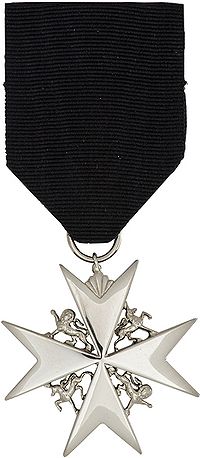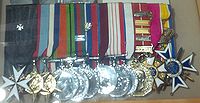The Order of St. John
The Order traces its origins back to the Knights Hospitaller in the Middle Ages, which was later known as the Order of Malta. A faction of them emerged in France in the 1820s and moved to Britain in the early 1830s, where, after operating under a succession of grand priors and different names, it became associated with the founding in 1882 of the St John Ophthalmic Hospital near the old city of Jerusalem and the St John Ambulance Brigade in 1887.
The order is found throughout the Commonwealth of Nations, Hong Kong, the Republic of Ireland, and the United States of America, with the worldwide mission "to prevent and relieve sickness and injury, and to act to enhance the health and well-being of people anywhere in the world." The order's approximately 25,000 members, known as confrères, are mostly of the Protestant faith, though those of other Christian denominations or other religions are accepted into the order. Except via appointment to certain government or ecclesiastical offices in some realms, membership is by invitation only and individuals may not petition for admission.[1]
The Order was brought into the Canadian Honours System in 1990. Her Majesty Queen Elizabeth II is the Order’s Sovereign, His Royal Highness Prince Richard, Duke of Gloucester, KG, GCVO, is the Grand Prior of the Order, and the Governor General is the Prior of the Priory and Chief Officer of the Order in Canada.
Canadians who have performed good services for the Order, mainly through its two foundations, the St. John Eye Hospital in Jerusalem and the St. John Ambulance Association and Brigade, may be admitted to the Order. There are five main levels to the Order and usually, one is admitted at the lowest grade and later promoted through the grades after some standard period of time. The grades are Bailiff or Dame Grand Cross, Knight or Dame of Justice or of Grace, Commander, Officer, and Member.
This Honour is administered by the Order of St. John.[2]
Description
The insignia of a Bailiff or Dame Grand Cross consists of a breast star and a sash badge. The star is in the shape of the insignia of the Order, 92mm across in gold and enamel but without embellishments (lions and unicorns in the angles), worn on the left breast, below any medals and the sash badge, which consists of the insignia of the Order in gold and enamel with embellishments, 82mm across, worn on the left hip suspended from a 102mm wide sash (57mm for Dames) that passes over the right shoulder.
The insignia of a Knight or Dame of Justice or of Grace consists of a breast star and a neck badge. The breast star is 76mm across, set in gold, without embellishments for Justice and in silver, with embellishments, for Grace, all enamelled white. The neck badge is the cross of the Order, 45mm across, with embellishments, set in gold for Justice and silver for Grace, enameled white.
The insignia of a Commander is a neck badge, 45mm across, set in silver and enameled white. Note that Dames and female Commanders usually wear the neck badge on a bow on the left shoulder.
The Officer insignia is silver and enameled white and worn on the left breast like other full-size medals.
The insignia of a Member is also worn on the left breast but is bright silver without enamel.
Bars
There is no bar to this medal.
Obverse
The badge consist of a true Maltese cross, an eight-pointed cross in white enamel set in silver-coloured metal. The cross is embellished in each of its principal angles with lions and unicorns, a lion being in the top left and bottom right angles. The insignia of Member has no enamel and is bright silver in colour.
Reverse
The reverse is flat and plain.
Ribbon
The ribbon for all grades of the Order is a black watered ribbon.
Mounting
The badges have a ring attached to the top through which the ribbon passes. On neck badges, there is a larger elongated ring through which the ribbon passes.
Dates
The Order was brought into the Canadian Honours System in 1990.
Naming
The medal is not named.

